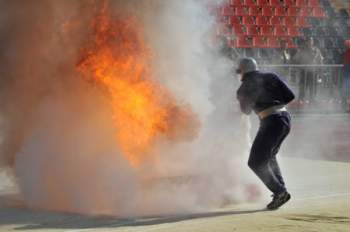
Fire Investigation

Are there Different Methods Used During a Fire Investigation
There are different methods depending on the type of fire (such as a wildfire or house fire), and fire marshals are trained to investigate these different types of fires. There are also different requirements for a suspected arson or an accidental fire.
This article will outline steps used by the National Wildfire Coordinating Group in a fire investigation of a wildfire.
Step 1 of Fire Investigation
While you’re en route to the fire, you should make not of the color, size, direction, and any changes in the smoke column. You should try and take license plate numbers and descriptions of vehicles you pass along the way as well. Take note of any gates (lock or unlocked) to the area of the fire, and make sure no commercial activities like construction, logging, or blasting caused the fire.
Step 2 of Fire Investigation
While arriving to the area, make note of any campers or evidence of people gathering in the area such as piles of trash, fire circles, or soil disturbance. Then, take the following steps:
· protect the area of origin or several areas
· secure the area with tape and keep people out of the area
· check if there was a lightning strike
· look for human causes
· if the fire is caused by human, contact a qualified investigator
· make weather readings including temperature, wind direction, and humidity
· take note of vehicles and license plate numbers that pass by the area of origin
· interview people at the area of origin
The investigator should obtain information from people at the area of origin, but all of the information obtained must be voluntary. The investigator cannot coerce anyone into telling them information. The investigator should take down their name, address, telephone number, and any other information they provided.
Step 3 of the Fire Investigation
The final step of the fire investigation is to find the exact origin of the wildfire. If the fire spread fast, look for boards or flat objects that were in the area of fire but only half charred. These object man show an angle that points back to the point of origin.
The following principles are used to identify an area of origin as well:
· look for areas that were damaged but less damaged that other areas because the fire was smaller and burned at a lower temperature in this area
· look along edges of a trail or a road
· fires on a flat piece of land will usually burn in a circular pattern so move toward the center of the burn pattern in such a case
· fires burning with the wind or uphill usually burn in a “V” shape, and the origin of the fire will usually lie around the point of the “V”
· look for signs of an advancing fire such as white ash, damage to the crowns of foliage, and a lack of grass stems
· the “heel” of the fire will show less char, smaller amounts of white ash, an burn angle that is parallel with a slope, and grass stems that are unburned
Source: http://www.nwcg.gov/pms/pubs/410-1/chapter14.pdf



















